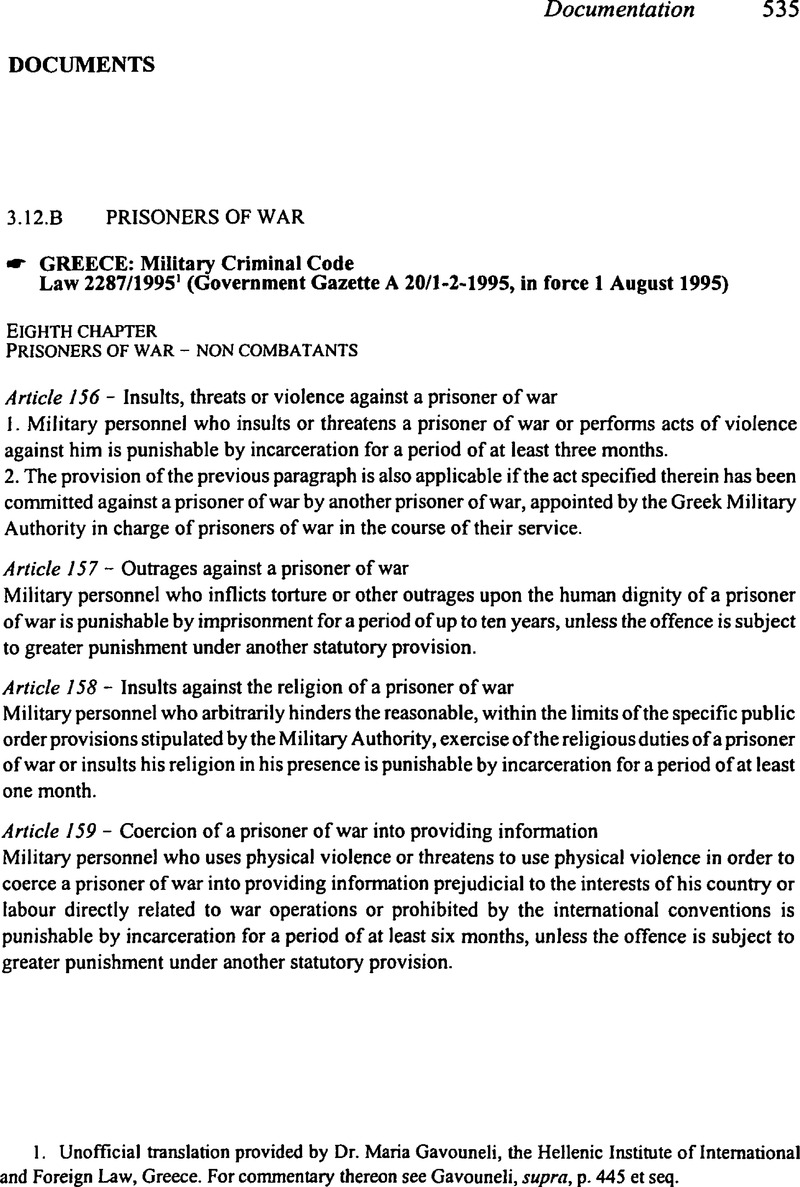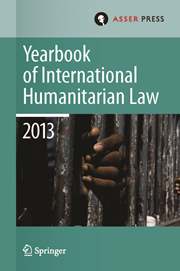No CrossRef data available.
Article contents
Documents
Published online by Cambridge University Press: 17 February 2009
Abstract

- Type
- Documentation
- Information
- Copyright
- Copyright © T.M.C. Asser Instituut and the Authors 1998
References
Page 535 note 1. Unofficial translation provided by Dr. Maria Gavouneli, the Hellenic Institute of International and Foreign Law, Greece. For commentary thereon see Gavouneli, supra, p. 445 et seq.
Page 537 note 2. According to Article 52 of the Greek Criminal Code, imprisonment may be imposed for life or for a period of no less than five and no more than twenty years. Incarceration, on the other hand, imposed for lighter offences, cannot extend to less than 10 days or more than five years (Art. 53).
Page 537 note 1. Prepared and annotated by Professor Ahmed Abou-El-Wafa, Professor at the Faculty of Law, Cairo University.
Page 537 note 2. The machinery of the League, as expressly embodied in the Pact, includes three principal organs, namely: the Council, Special Committees and the Secretariat General. The League Council is the plenary organ of the organization i.e., it is composed of representatives of all member states (Art. 3 of the Pact). Thus, all members are represented in the Council on an equal footing. The Council meets at the level of foreign ministers, their representatives or permanent delegates. The League Council is the supreme organ within the organization. It is the main policy-making body. See Abou-El-Wafa, Ahmed: A manual on the law of international organizations: an analysis of some international organizations, dar Al-Nahda Al-Arabia, Cairo, 1998, pp 174–175Google Scholar.
Page 537 note 3. Cf, Resolutions of the Council of the LAS in its ordinary session 108, LAS – The Secretariat General, Cairo, September 1997, p. 6 (in Arabic). This is not the first time that the League Council refers to the Fourth Geneva Convention relative to the protection of civilian persons in time of war. In fact, such reference has been contained in many resolutions of the Council, the most important of which are the following: Res. 1595 (7/9/1959); Res. 2456 (3/9/1968); Res. 3618 (6/9/1977); Res. 5366 (27/3/1994); and Res. 5628 (31/3/1997).
Page 538 note 4. Ibid, p. 16.
Page 538 note 5. Ibid, p. 22. During its Tenth Extraordinary Session, the General Assembly of the United Nations adopted Resolution 10/3 on 10 July 1997 which provides that the General Assembly: ‘Recommends that the High Contracting Parties to the Geneva Convention relative to the protection of civilian persons in time of war convene a conference on measures to enforce the Convention in the occupied Palestinian territory, including Jerusalem, and to ensure its respect, in accordance with common article 1, and requests the Secretary-General to present a report on the matter within three months’.
Page 538 note 6. Ibid., p. 25. On the same subject, the League Council previously adopted similar resolutions. See e.g., Resolutions 5633 (31/3/1997); 5585 (15/9/1996); 5542 (21/3/1996); 5493 (21/9/1995); 5323 (21/9/1993); 5168 (27/4/1992); and 4126 (13/1/1982).
Page 539 note 7. Ibid., p. 29.
Page 539 note 8. Cf, Report of the Secretary-General between the two sessions of the Council 107–108, The Secretariat-General, LAS, Cairo, September 1997, p. 23 (in Arabic).
page 561 note 1. Entered into force 1 January 1997. Published 10 January 1997 in Bundesgesetzblatt nr. 263/1996. Working translation provided by Federal Ministry of Justice.
page 562 note 1. For commentary, see Lauri Hannikainen at p. 436 et seq.
page 563 note 1. Published (in Italian) in Supplemento ordinario alla Gazetta Ufficiale, series generate, n. 276, 25 November 1995. For commentary, see Gargiulo, supra p. 323.
page 598 note 1. Unofficial translation by Wesseling Plug, Ms. Louise. Printed in French in the Revue générale de Droit international public, tome 102, 1998/3, pp. 825–832Google Scholar, with a comment by Denis Alland and Frederique Ferrand.
page 600 note 1. Unofficial translation by Mr. Peter Kell.
page 608 note 1. A Prefecture is roughtly equivalent to a State within the United States, and a Commune is roughly equivalent to a county within a state.
page 608 note 2. For many hundreds of years there has been ethnic fighting between Tutsis and Hutus in Rwanda. The Hutus are the ethnic majority in Rwanda and comprised 84% of the population in 1994. At that time Tutsis comprised 14% of the population of Rwanda. Historically, Tutsis have held disproportionate levels of wealth and political power in Rwanda dating back to British Imperialist days and beyond.
page 608 note 3. The Bisesero region is a mountainous region of Rwanda that spans two communes.
page 608 note 4. The record is unclear as to when the Extraditee arrived in the United States. The Government contends that he remained in Rwanda in the months following the Mugonero attack and led the attacks in the Bisesero region. The Extraditee contends that he fled the Mugonero compound on the morning of April 16, 1994, and did not return to the area. What is undisputed is that at some point the Extraditee was admitted to the United States and was residing here legally when he was arrested.
page 609 note 5. This same law authorized the surrender of persons to a similar U.N. tribunal investigating charges of genocide in the former Yugoslavia. The Court expresses no opinion on the Constitutional efficacy of those provisions.
page 614 note 6. Genocide is defined by the Tribunal in U.N. security counsel Resolution 955, Article 2, Paragraph 2 as:
‘any of the following acts committed with the intent to destroy, in whole or in part, a national, ethnical, racial or religious group, as such:
(a) Killing members of the group;
(b) Causing serious bodily or mental harm to members of the group;
(c) Deliberately inflicting on the group conditions of life calculated to bring about its physical destruction in whole or in part;
(d) Imposing measures intended to prevent births within the group;
(e) Forcibly transferring children of the group to another group.’
page 615 note 1. Unofficial translation by Ms. Louise Wesseling Plug.
page 616 note 1. Unofficial translation by Ms. Louise Wesseling-Plug.
page 617 note 1. Reprinted from The Army Lawyer, Headquarters, Department of the Army, June 1998.
page 617 note 2. Chairman, Joint Chiefs of staff Instr. 5810.01. Implementation of the DOD Law of War Program, 12 Aug. 1996. Hereinafter JCS Instr. 5810.01.
page 617 note 3. U.S. Dep't of Defence. Dir. § 100.77. DOD Law of War Program (10 July 1979) [hereinafter DOD Dir. § 100.77].
page 617 note 4. ICS Instr. 5810.01, supra n. 2, para. 4 1.
page 617 note 5. The United States Army defines Operations Other Than War as ‘[U]se of Army forces in peacetime … ’ U.S. Dep't of Army Field Manual 100–5, Operations 2–8 (14 June 1993). Examples of peacetime use of the Army include ‘disaster relief, nation assistance, security and advisory assistance, counterdrug operations, arms control, treaty verification, support to domestic civil authorities, and peacekeeping,’ Id. At 2–0–1. The DOD Dictionary defines Operations Other Than War as follows:
Military operations other than war—(DOD) Operations that encompass the use of military capabilities across the range of military operations short of war. These military actions can be applied to complement any combination of the other instruments of national power and occur before, during, and after war. Also called MOOTW.
U.S. Dep't of Defense, Joint Publication 1–02, DOD Dictionary (23 Mar. 1994) (updated through April 1997).
page 618 note 6. See JCS Instr. 5810.01, supra n. 2.
page 618 note 7. See supra n. 2 and accompanying text.
page 618 note 8. International law … consisists of rules and principles of general application dealing with the conduct of states . . with these relations inter se …’ Restatement Third of the Foreign Relations Law of the United States; 101 (1986).
page 618 note 9. See Anthony D'Amato, International Law Anthology 41–48 (1994).
page 618 note 10. U.S. Dep't of Army. Field Manual 27–10, The Law of Land Warfare 9 July 1956 (CI, 15 July 1976) [hereinafter FM27–10]. ‘As the customary law of war applies to cases of international armed conflict and to forcible occupation of enemy territory generally as well as to declared war in its strict sense, a declaration of war is not an essential condition for the application of this body of law.’ Id (emphasis added). See Geneva Convention for the Amelioration of the Condition of the Wounded and Sick in Armed Forces in the Field, Aug. 12 1949, Art. 2–3 T.I.A.S. No. 3362 [hereinafter GWS]; Geneva Convention for the Amelioration of the Condition of Wounded, Sick, and Shipwrecked Members at Sea, Aug. 12, 1949, art. 2–3, T.I.A.S No. 3363 [hereinafter GWS Sea]; Geneva Convention Relative to the Treatment of Prisoners of War, Aug. 12, 1949, art. 2–3 T.I.A.S. No. 3364 [hereinafter GPW]; Geneva Convention Relative to the Treatment of Civilian Persons in Time of War, Aug. 12, 1949, art. 2–3, T.I.A.S. No. 3365 [hereinafter GC]; 1977 Protocol I Additional to the Geneva Conventions. Dec. 12 1977, art. 1, 16 I.L.M. 1391; 1977 Protocol II Additional to the Geneva Conventions, Dec. 12, 1977, art. 1, 16 I.L.M 1391 [hereinafter GPII]. One commentator notes:
Humanitarian law also covers any dispute between two States involving the use of their armed forces. Neither the duration of the conflict, nor its intensity, play a role: the law must be applied to the fullest extent required by the situation of the persons and the objects protected by it.
Commentary on the Additional Protocols of 8 June 1977 to the Geneva Conventions of 12 August 1949, at 40 (Yves Sandoz et al. eds., 1987).
page 619 note 11. See generally FM 27–10, supra n. 10 at 9. See also Richard I. Miller, The Law of War 17–27(1975).
page 619 note 12. See GWS, supra note 10, art. 3; GWS Sea, supra note 10, art. 3, GPW, supra note 10, art. 3; GC, supra note 10, art. 3.
page 619 note 13. See supra n. 12; see also GP II, supra n.
page 619 note 14. JCS Instr. §810.01, supra n. 2, para 43.
page 619 note 15. See supra note 10 and accompanying text
page 619 note 16. Source: Ministry of Justice, Finland.
page 621 note 1. Unofficial translation provided by Professor Alfonso Velásquez.
page 623 note 1. Translation provided by the International Committee of the Red Cross. Thanks to Professor Raúl Vinuesa and Mr. Jean-Marie Henckaerts.
page 636 note 1. Translation provided by Professor Antoni Pigrau i Solé.


